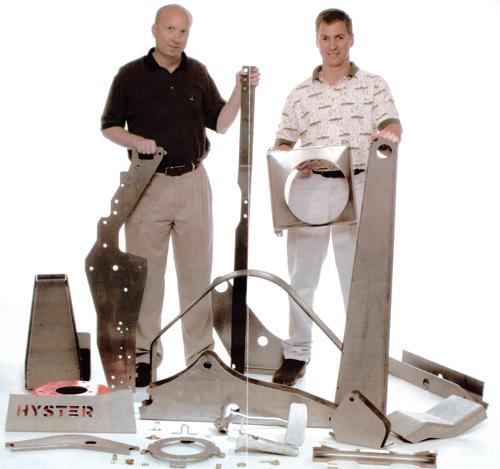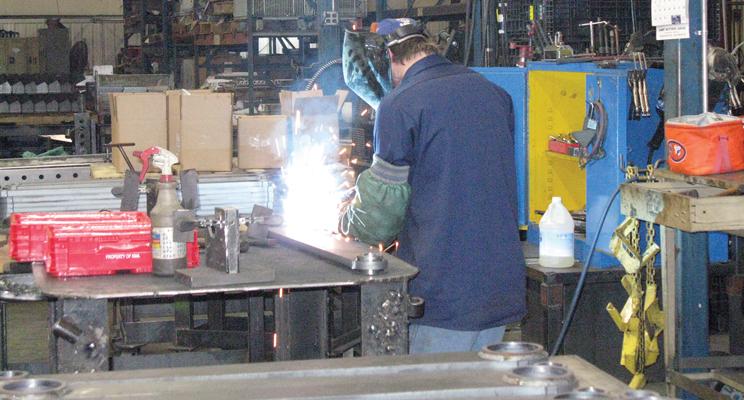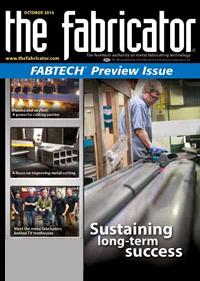Senior Editor
- FMA
- The Fabricator
- FABTECH
- Canadian Metalworking
Categories
- Additive Manufacturing
- Aluminum Welding
- Arc Welding
- Assembly and Joining
- Automation and Robotics
- Bending and Forming
- Consumables
- Cutting and Weld Prep
- Electric Vehicles
- En Español
- Finishing
- Hydroforming
- Laser Cutting
- Laser Welding
- Machining
- Manufacturing Software
- Materials Handling
- Metals/Materials
- Oxyfuel Cutting
- Plasma Cutting
- Power Tools
- Punching and Other Holemaking
- Roll Forming
- Safety
- Sawing
- Shearing
- Shop Management
- Testing and Measuring
- Tube and Pipe Fabrication
- Tube and Pipe Production
- Waterjet Cutting
Industry Directory
Webcasts
Podcasts
FAB 40
Advertise
Subscribe
Account Login
Search
The human side of selling a business
How GH Metal Solutions became part of reliance Steel & Aluminum Co.
- By Tim Heston
- October 30, 2014
- Article
- Shop Management
In 2003 Richard Stout, Alan Kilgo, and Edwin Stanley were in a good place. Each owned, or were soon to own, about a third of GH Metal Solutions. The contract metal fabricator operated out of several buildings in downtown Fort Payne, Ala., which hugs the southern Appalachian foothills. The three talked frequently about technology, future growth, operational efficiencies, and better ways to serve the customer. But, understandably so, they didn’t talk about tragedy; they didn’t ask what would happen if one of them should die.
In 2005, cancer answered that question for them.
Reliance Steel & Aluminum Co., through its Chicago-based subsidiary Feralloy Corporation, purchased the business in 2012, and today GH Metal is thriving. How the fabricator got to where it is today is a complex tale, one of loss, of difficult choices. But it’s also a story about how a business can emerge from a crisis even stronger than before.
From Gas to Metal
Warren Stout, along with several other business partners, launched the company in 1958 to serve an entirely different business. If people wanted a gas furnace or gas stove to hook into the gas lines, which had just became available in Fort Payne, they would call Stout’s new company, at the time aptly named The Gas House. Eventually Stout bought his business partners out, and over the years the small business hummed along.
After working as a young engineer in Maryland, Stout’s son Don moved back to Fort Payne in the 1970s. As Warren’s health started to decline, Don eventually took over. During the next decade, two more partners came into the business: Harold Kilgo in the late 1970s and John Ingraham in the early 1980s.
During the ensuing years, The Gas House became more than, well, a gas house. It branched out into stamping, making roof vents for a manufactured-home company and, eventually, for improvement projects supported by the Tennessee Valley Authority, which was encouraging customers to save energy by installing roof vents on their homes.
Not long after, other area OEMs came to The Gas House for stamping work. The company’s contract manufacturing business continued to grow, so much so that the owners spun off the original gas equipment business into a separate company, which operates in Fort Payne to this day.
The Gas House was no longer a gas house, but a bona fide contract metal stamper and fabricator, owned by three individuals. Over the decades Harold’s son Alan became involved in the business, as did Don’s son Richard. John Ingraham’s children weren’t interested in joining the company, and so a Stout family friend, Edwin Stanley, who also happened to be an experienced manufacturing manager, came onboard in 1999, intending to buy out Ingraham’s interest four years later.
Whence came the company’s third generation: Richard Stout, Alan Kilgo, and Edwin Stanley. Things were looking up in the 2000s, during which the second generation was starting to hand ownership over to the third—until the unthinkable happened. Richard, the founder’s grandson, became sick with cancer, stopped coming to work, and all too soon died in May 2005. This shocked everyone, and it changed everything.
Surviving the Unthinkable
As Stanley recalled, during the first months after Richard’s death, the organization went into “survival mode.” The business partners took care of Richard’s family by buying back his stock from Richard’s estate and, in doing so, took on significant debt. “We learned a lesson,” Stanley recalled. “We didn’t have any insurance to cover Richard’s death, but we needed to take care of his family.”

In the early 2000s, Richard Stout (left) and Alan Kilgo, along with Edwin Stanley (not pictured), were ready to become GH Metal Solutions’ third generation of owners. But after May 2005, everything changed.
Eventually something dawned on the owners: The best option—especially for the employees—might be to sell the company. It wasn’t an easy decision. Considering the company’s debt, none of the owners would leave the table terribly rich. But the right strategic buyer would keep people onboard, and the fabricator would remain a major employer in the Fort Payne community.
Despite its debt, the fabricator continued to make money, and it obtained its ISO 9001 certification in 2006—both pluses for any potential buyer. So the following year managers started talking to potential suitors, but they soon ran into a problem. Although the company had respectable earnings, 70 percent of sales came from just two major customers. For buyers, the company’s customer concentration was just too high.
So the owners took the company off the market and began to make changes. They initiated a sales and marketing effort in earnest, hiring a sales force to go after new accounts.
They also moved all equipment over to a new plant outside of town, near the small Fort Payne airport. Sure, its old buildings downtown, including one that used to be a cotton warehouse, had character and housed plenty of modern equipment. “But they didn’t show well,” Stanley said.
In 2009 the owners formally changed the company name to GH Metal Solutions, which better reflected the services the company provided, and they continued to invest in new equipment to build fabrication capacity. “We continued to invest in the company to grow sales, even though the economy wasn’t very good,” Stanley said, adding that investment had risk, but without it, the company might not be where it is today.
GH Metal Solutions had never experienced a serious sales contraction until 2009, when sales volume from its two major customers dropped significantly. “That time taught us that things aren’t always good,” Stanley said. “Up until that time, some years were better than others, but we had always made a little bit of money. In 2009, of course, we really struggled to make ends meet. When we were coming back out of it, we knew this could happen again. And we knew it would take us several years to recover and be in a good position to sell the company.”
Finding a Buyer
It actually took only two years, mainly because the fabricator’s sales team was planting seeds for future success. During the recession many OEMs not only were looking to cut costs, but were also worried about the financial viability of their current suppliers. Some of GH Metal’s competitors didn’t survive the downturn. Timing, it seemed, was on the fabricator’s side. As the recovery ensued, GH Metal continued to add customers.
The owners didn’t talk to financial buyers who wanted to flip the company and cash out in several years. Neither did they talk to anyone interested in a bolt-on, in which the acquirer buys a company mainly for its customer base and manufacturing technology: laser cutting systems, combination laser/punch, a tube laser, press brakes, flexible robotic welding cells, high-capacity powder coating and e-coating, and machining for making welding fixtures and forming tools.
They instead wanted a strategic buyer interested in retaining employees. In other words, they wanted a buyer who wanted not just the fabricator’s customer base and machines, but also its talent. For this to work, the buyer had to be in a complementary area, one that aligned but didn’t compete with GH Metal’s core business.
In 2012 the owners—which by that time included Brad Scott, the company’s general manager—received an offer from such a buyer: Reliance Steel & Aluminum Co. The owners knew that the nationwide service center was looking to expand further into metal fabrication. After talking with managers at other companies that Reliance had previously acquired, they learned that, as a parent company, the organization takes a hands-off approach.
“We wanted to be sure it would be a good partnership,” Stanley said, “and that the buyer would operate the business as we would operate the business. Some buyers want to buy your customer base. They close your plant, then transfer you to their existing facility to reduce their overhead expenses. That wasn’t the way we wanted it, because we didn’t want our employees, whom we’re really close with, to have to start looking for jobs. But Reliance wasn’t interested in that. They were interested in us continuing to run the business.”
The new parent corporation isn’t invisible. The company improved its inventory control and other practices to comply with Reliance’s accounting practices, for instance. But as was agreed upon before the deal closed, the company continues to operate in its facility near Fort Payne.
About People
“The chemistry between the buyer and seller is very important,” Stanley said. After knowing the buyer’s intent, talking to others, and performing all the associated due diligence—the concrete factors that ensure the match makes business sense—all that’s left is chemistry. People have to get along. As Stanley recalled, the chemistry between GH Metal and Reliance was obvious at the outset, and the due diligence and research supported the owners’ assumptions.
“The chemistry was there, but it was still a tough decision,” Stanley added, “as I think it would be for any business owner. We went back and forth—should we sell or not sell? We had three families involved, not just one, so it was a team decision. But in the end, it was the right decision.”
Kilgo retired in the fall of 2013, but Scott and Stanley remain at GH Metal, Stanley as vice president and Scott as general manager. The details of the acquisition remain private, including the purchase price and the multiple of EBITDA (earnings before interest, taxes, depreciation, and amortization). But the experience showed how important certain attributes of managing a fabrication business really are, and those attributes don’t always show up on an income statement.
If GH Metal had had insurance to cover Richard Stout’s death, would the fabricator have been sold? It’s impossible to guess, and it’s really beside the point. Whether or not owners are preparing a business for sale, managing by valuation forces them to look at their business objectively. That’s good practice even if owners have no plans to sell.
An e-book called What’s Your Business Worth?, published last year by the Fabricators & Manufacturers Association International®, puts it succinctly: “Every business will eventually change ownership or cease to exist.” The book was written by FMA’s Valuation and Strategy Subcommittee of the Management Advisory Council. On that subcommittee is consultant Dick Kallage (author of this magazine’s Improvement Insights column) as well as Stanley, who obviously has recent experience with both valuation and strategy. The book describes the key financial parameters that determine what buyers will pay for a business: the amount and stability of revenue; current and historical margins (gross, operating, and EBITDA); financial controls; quality of the asset; and return on net assets (RONA).
But the engaging part of a successful transaction is human. Good numbers get the parties to the table, but it’s the people who get the deal done; it’s the people who work to uncover the best each organization has to offer; and, under the best circumstances, it’s the people who ultimately benefit. For instance, at this writing, at least one shop supervisor at GH Metal has moved up the career ladder to a management position at another Reliance facility in Alabama. Before, such opportunity really didn’t exist.
About the Author

Tim Heston
2135 Point Blvd
Elgin, IL 60123
815-381-1314
Tim Heston, The Fabricator's senior editor, has covered the metal fabrication industry since 1998, starting his career at the American Welding Society's Welding Journal. Since then he has covered the full range of metal fabrication processes, from stamping, bending, and cutting to grinding and polishing. He joined The Fabricator's staff in October 2007.
Related Companies
subscribe now

The Fabricator is North America's leading magazine for the metal forming and fabricating industry. The magazine delivers the news, technical articles, and case histories that enable fabricators to do their jobs more efficiently. The Fabricator has served the industry since 1970.
start your free subscription- Stay connected from anywhere

Easily access valuable industry resources now with full access to the digital edition of The Fabricator.

Easily access valuable industry resources now with full access to the digital edition of The Welder.

Easily access valuable industry resources now with full access to the digital edition of The Tube and Pipe Journal.
- Podcasting
- Podcast:
- The Fabricator Podcast
- Published:
- 04/16/2024
- Running Time:
- 63:29
In this episode of The Fabricator Podcast, Caleb Chamberlain, co-founder and CEO of OSH Cut, discusses his company’s...
- Industry Events
16th Annual Safety Conference
- April 30 - May 1, 2024
- Elgin,
Pipe and Tube Conference
- May 21 - 22, 2024
- Omaha, NE
World-Class Roll Forming Workshop
- June 5 - 6, 2024
- Louisville, KY
Advanced Laser Application Workshop
- June 25 - 27, 2024
- Novi, MI


































